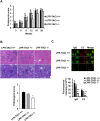Delayed onset of autoreactive antibody production and M2-skewed macrophages contribute to improved survival of TACI deficient MRL-Fas/Lpr mouse
- PMID: 29358664
- PMCID: PMC5778001
- DOI: 10.1038/s41598-018-19827-8
Delayed onset of autoreactive antibody production and M2-skewed macrophages contribute to improved survival of TACI deficient MRL-Fas/Lpr mouse
Abstract
Anti-B cell activating factor belonging to TNF-family (BAFF) antibody therapy is indicated for the treatment of patients with active systemic lupus erythematosus (SLE). We hypothesized that the BAFF receptor, transmembrane activator and calcium-modulator and cyclophilin interactor (TACI) may be responsible for the generation of antibody secreting plasma cells in SLE. To test this hypothesis, we generated TACI deficient MRL-Fas/Lpr (LPR-TACI-/-) mouse. TACI deficiency resulted in improved survival of MRL-Fas/Lpr mice and delayed production of anti-dsDNA and anti-SAM/RNP antibodies. There was also a delay in the onset of proteinuria and the accumulation of IgG and inflammatory macrophages (Mϕs) in the glomeruli of young LPR-TACI-/- mice compared to wild-type mice. Underscoring the role of TACI in influencing Mϕ phenotype, the transfer of Mϕs from 12-week-old LPR-TACI-/- mice to age-matched sick wild-type animals led to a decrease in proteinuria and improvement in kidney pathology. The fact that, in LPR-TACI-/- mouse a more pronounced delay was in IgM and IgG3 autoreactive antibody isotypes and the kinetics of follicular helper T (Tfh) cell-development was comparable between the littermates suggest a role for TACI in T cell-independent autoantibody production in MRL-Fas/Lpr mouse prior to the onset of T cell-dependent antibody production.
Conflict of interest statement
The authors declare that they have no competing interests.
Figures






Similar articles
-
Circulating CD138 enhances disease progression by augmenting autoreactive antibody production in a mouse model of systemic lupus erythematosus.J Biol Chem. 2021 Sep;297(3):101053. doi: 10.1016/j.jbc.2021.101053. Epub 2021 Aug 6. J Biol Chem. 2021. PMID: 34364875 Free PMC article.
-
CAR-T cell targeting three receptors on autoreactive B cells for systemic lupus erythematosus therapy.J Autoimmun. 2025 Feb;151:103369. doi: 10.1016/j.jaut.2025.103369. Epub 2025 Jan 19. J Autoimmun. 2025. PMID: 39832454
-
Differential Development of Systemic Lupus Erythematosus in NZM 2328 Mice Deficient in Discrete Pairs of BAFF Receptors.Arthritis Rheumatol. 2015 Sep;67(9):2523-35. doi: 10.1002/art.39210. Arthritis Rheumatol. 2015. PMID: 25989238
-
Use of genetic knockouts to modulate disease expression in a murine model of lupus, MRL/lpr mice.Immunol Res. 2002;25(2):143-53. doi: 10.1385/ir:25:2:143. Immunol Res. 2002. PMID: 11999168 Review.
-
Unique site of IgG2a and rheumatoid factor production in MRL/lpr mice.Immunol Rev. 1997 Apr;156:103-10. doi: 10.1111/j.1600-065x.1997.tb00962.x. Immunol Rev. 1997. PMID: 9176703 Review.
Cited by
-
Azithromycin alleviates systemic lupus erythematosus via the promotion of M2 polarisation in lupus mice.Cell Death Discov. 2021 Apr 16;7(1):82. doi: 10.1038/s41420-021-00466-4. Cell Death Discov. 2021. PMID: 33863874 Free PMC article.
-
Azithromycin promotes alternatively activated macrophage phenotype in systematic lupus erythematosus via PI3K/Akt signaling pathway.Cell Death Dis. 2018 Oct 22;9(11):1080. doi: 10.1038/s41419-018-1097-5. Cell Death Dis. 2018. PMID: 30348950 Free PMC article.
-
Increased Expression of PPAR-γ Modulates Monocytes Into a M2-Like Phenotype in SLE Patients: An Implicative Protective Mechanism and Potential Therapeutic Strategy of Systemic Lupus Erythematosus.Front Immunol. 2021 Jan 19;11:579372. doi: 10.3389/fimmu.2020.579372. eCollection 2020. Front Immunol. 2021. PMID: 33584646 Free PMC article.
-
Impaired B Cell Apoptosis Results in Autoimmunity That Is Alleviated by Ablation of Btk.Front Immunol. 2021 Aug 26;12:705307. doi: 10.3389/fimmu.2021.705307. eCollection 2021. Front Immunol. 2021. PMID: 34512628 Free PMC article.
-
Disease Stage-Specific Pathogenicity of CD138 (Syndecan 1)-Expressing T Cells in Systemic Lupus Erythematosus.Front Immunol. 2020 Jul 28;11:1569. doi: 10.3389/fimmu.2020.01569. eCollection 2020. Front Immunol. 2020. PMID: 32849532 Free PMC article.
References
Publication types
MeSH terms
Substances
LinkOut - more resources
Full Text Sources
Other Literature Sources
Medical
Molecular Biology Databases
Research Materials
Miscellaneous

